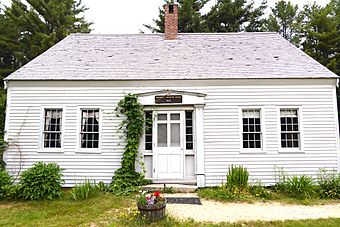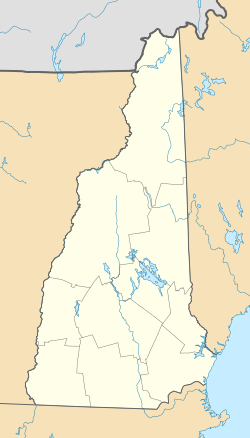Russell-Colbath House facts for kids
Quick facts for kids |
|
|
Russell/Colbath House
|
|
 |
|
| Location | Kancamagus Hwy., White Mountain National Forest, Albany, New Hampshire |
|---|---|
| Area | 1 acre (0.40 ha) |
| Built | 1831 |
| Built by | Russell, Amzi; Russell, Thomas |
| NRHP reference No. | 86003416 |
| Added to NRHP | April 23, 1987 |
The Russell/Colbath House is a special old home located on the Kancamagus Highway in Albany, New Hampshire. It sits inside the beautiful White Mountain National Forest. Today, it works as a museum run by the United States Forest Service. This house was built around 1831. It is the only original old home left from the early days in the Swift River valley. Because of its history, it was added to the National Register of Historic Places in 1987.
Contents
The Story of the Russell/Colbath House
The Russell-Colbath House is on the north side of the Kancamagus Highway. It is between the Jigger Johnson Campground and Oliverian Brook Road. This house is a one-and-a-half-story building made of wood. It has a pointed roof and a chimney in the middle. The outside is covered with wooden boards.
What the House Looks Like
The front of the house is balanced with five sections. The main door is in the middle. It has windows on each side and simple decorations above. Inside, the house has a large chimney in the center. There is a small entry area. Living rooms are on both sides of the chimney. A bedroom is located behind the chimney. A small space in the northeast corner holds a kitchen area. Stairs in this area lead up to the bedrooms on the top floor.
Who Lived Here?
Thomas and Amzi Russell built this house between 1831 and 1832. It is the only 19th-century home still standing in the Swift River valley. The Russells were some of the first people to settle permanently in this area. They arrived in the 1820s. Before them, other attempts to settle here in 1805 and 1815 did not work out.
The Russell family ran a sawmill on Oliverian Brook. They were part of a small community that farmed and cut down trees. This area had some of the best farmland in the valley. The Russell family owned the house until 1930. After that, it was used as a summer home for a while.
A Museum Today
The United States Forest Service bought the house in 1961. Since then, they have used it as a museum. It also serves as an information center for visitors. It helps people learn about the history of the Swift River valley.



